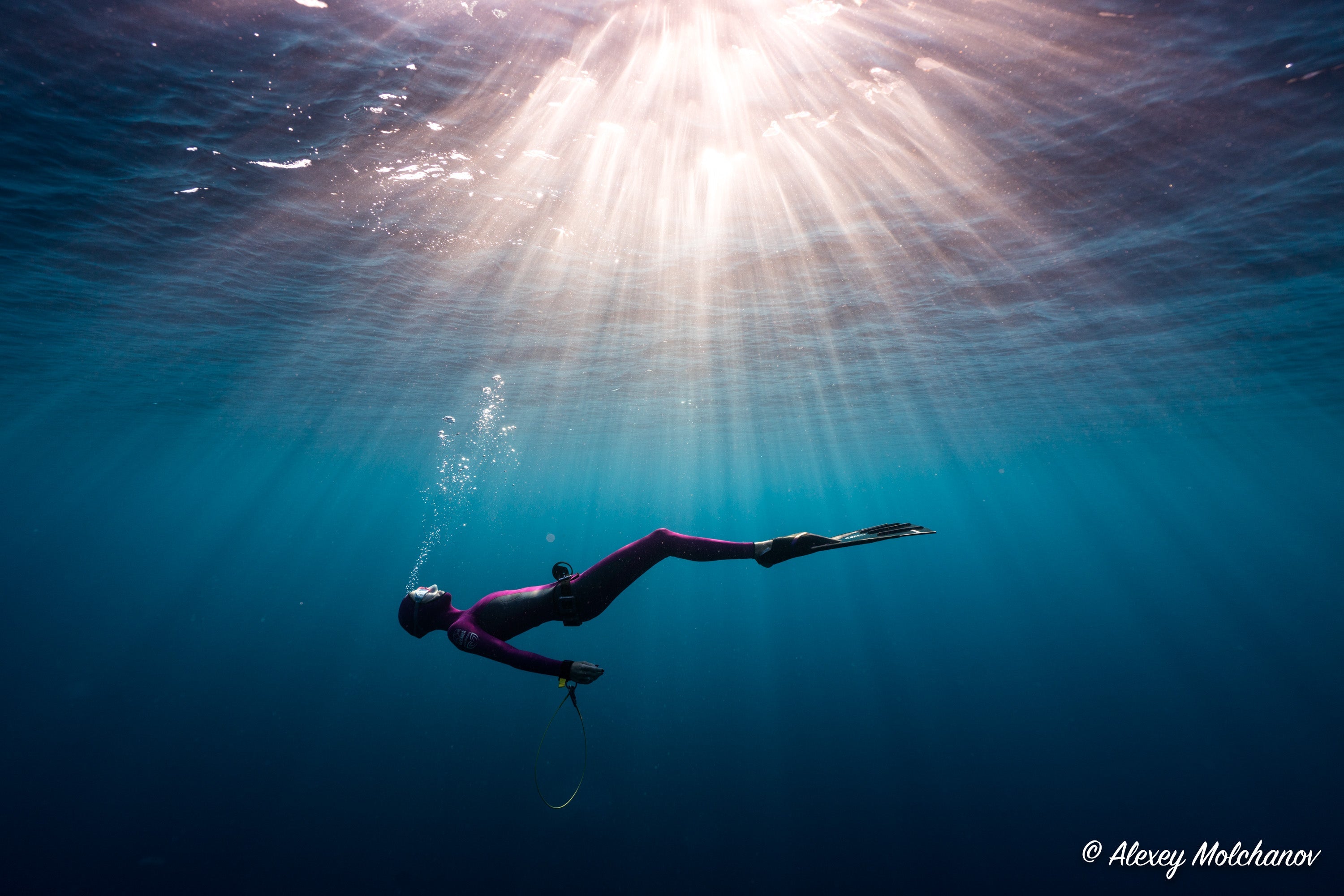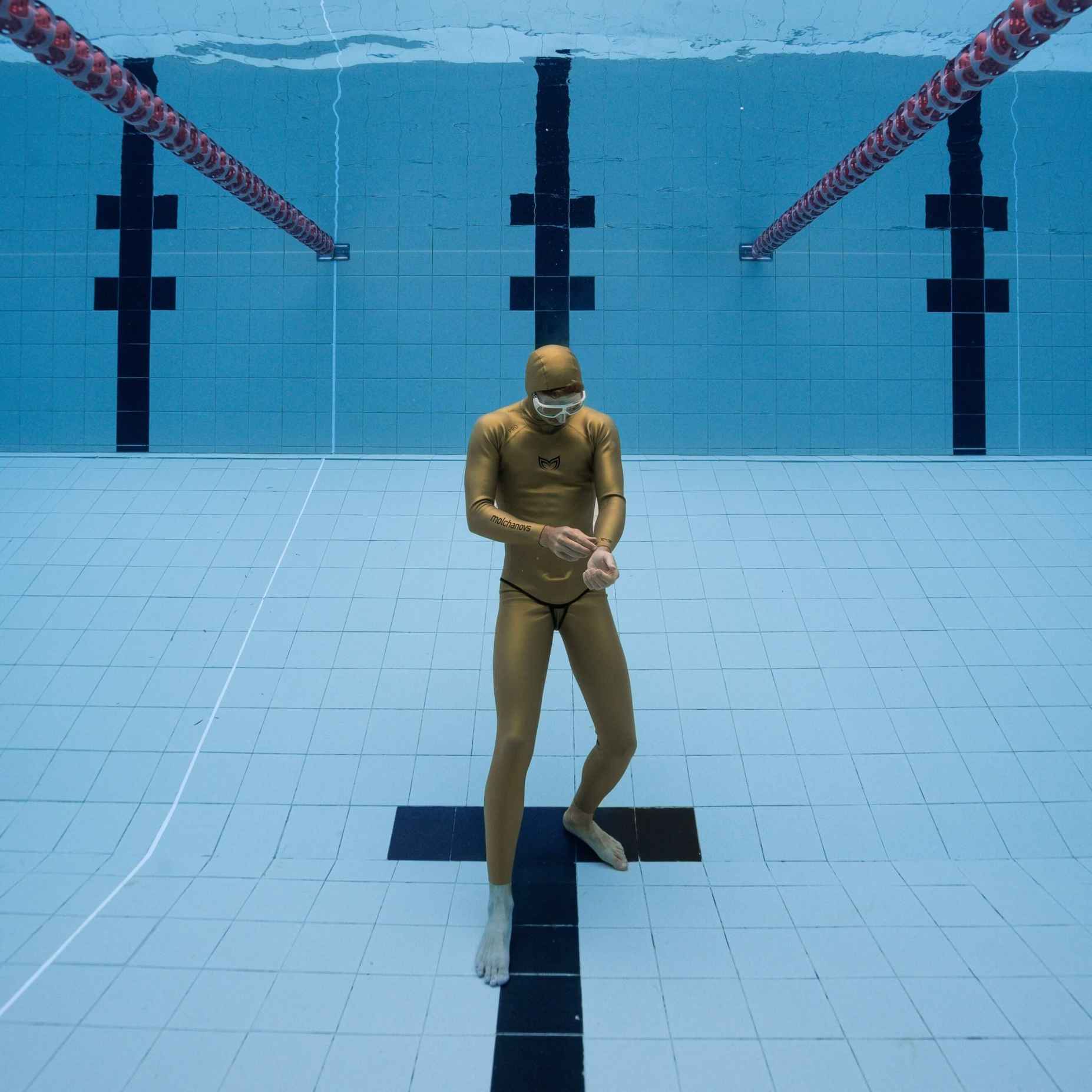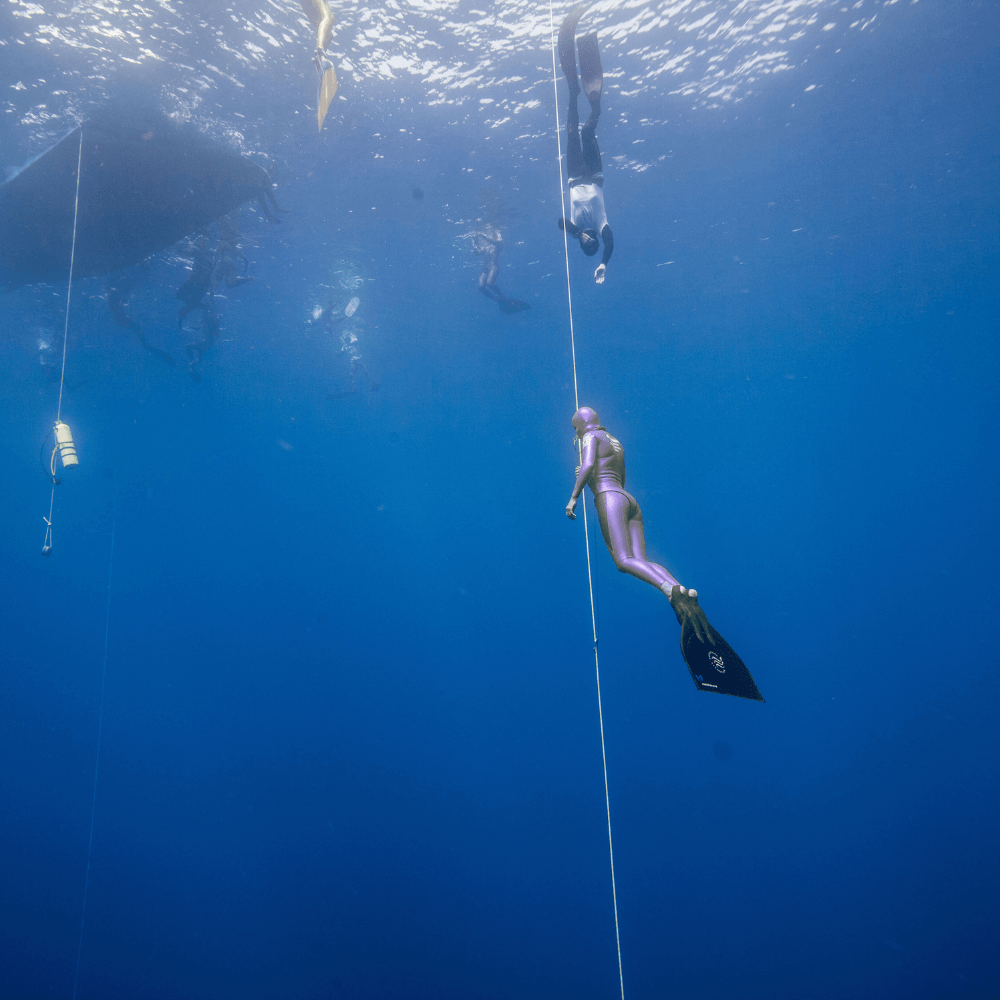What is Freediving?

You may have seen movies that feature freediving, you may have read books that make a mention of it, or you may have encountered news pieces on freediving competitions and world records. You may have even had a friend come back from a vacation and show off their recently acquired freediving certification, along with amazing photos and videos from under the sea and a new pair of impressively long fins. Freediving is actually one of the oldest forms of diving, but has been growing steadily in popularity as a sport in recent decades. But what exactly is freediving?
Freediving is the practice of holding your breath when diving underwater without the use of breathing equipment, such as a scuba tank. Freediving is a way of life for some, a competitive sport for others, and a hobby for many. Read on to find out more information about what freediving is, the benefits that come with it, where you can freedive, and why people are doing it.
Recreational Freediving
Recreational freediving is freediving for leisure, such as on vacation or training (non-competitively) with a certified buddy. People freedive recreationally for many reasons: to challenge themselves physically and mentally, to take beautiful underwater photos, to improve their mental health, to explore the underwater world, or to improve their fitness. The reasons are endless. But most freedivers will mention the feeling of peace and calm they have when they dive, and how they use it as a form of meditation and feeling connected to their surroundings.
Applied Freediving
Applied freediving is freediving with a purpose, such as hunting for seafood, various underwater sports, or performing scientific research. Freediving can be a part of daily life for some people, like the female “Ama” divers in Japan that collect pearls and seafood, or the Bajau tribes of Indonesia, Malaysia, and the Philippines, who live at the sea and spearfish. Freediving encompasses their existence and is part of their way of life.
Competitive Freediving
Competitive freedivers are athletes who dedicate their training to participate in competitions. There are lifestyle sport freedivers who join competitions to challenge themselves and improve their skills, and professional sport freedivers who compete to break national and world records. All competitive freedivers use advanced techniques and train rigorously in and out of the water with a level of total commitment as a freediving athlete. Their physical, in-water training is often supplemented with other types of cross-training, mental training, diet, and rest. The physical limits of the human body are still unknown as freedivers continue to dive deeper and longer, with seemingly no end to their limits in sight.
Here are 10 disciplines of freediving that are quite famous and well-known.
Static Apnea (STA)
Static Apnea is performed on the surface of a pool. Freedivers do not wear weights and do not move, only hold their breath for an extended period of time. This is the only freediving discipline which is measured by duration rather than depth or distance.
Current world records at the time of this article are over 9 minutes for women and over 11 minutes for men.
Dynamic With Fins/Bifins (DYNB/DYN)
Dynamic with Fins/Bifins is performed under the surface of water in a pool. Freedivers dive horizontally for distance on a single breath, and may use either a monofin for DYN or bifins for DYNB.
The current world records for DYN are 257m (843ft) for women and 300m (984ft) for men. The current world records for DYNB are 208m (682ft) for women and 250m (820ft) for men.

Dynamic No-Fins (DNF)
Dynamic No-Fins is performed under the surface of water in a pool. Freedivers dive horizontally for distance on a single breath without fins, using only arm strokes and frog kicks.
The current world records for DNF are 191m (626ft) for women and 244m (800ft) for men.
Free Immersion (FIM)
Free Immersion is performed in open water. Freedivers wear a minimal amount of weight around the hips or neck and attempt to reach a target depth on a vertical line by pulling their way down and up, all on a single-breath.
The current world records for FIM are 98m (321ft) for women and 125m (410ft) for men.

Constant Weight with Fins/Bifins (CWT/CWTB)
Constant Weight with Fins/Bifins is performed in open water. Freedivers wear a minimal amount of weight (called constant weight since this weight will stay with them throughout the entire dive) and attempt to reach a target depth on a vertical line by finning on a single breath, either with a monofin for CWT or bifins for CWTB.
The current world records for CWT are 107m (351ft) for women and 130m (427ft) for men. The current world records for CWTB are 92m (301ft) for women and 112m (361ft) for men.
Constant Weight No-Fins (CNF)
Constant Weight No-Fins is performed in open water. Freedivers wear a minimal amount of weight and attempt to reach a target depth on a vertical line by swimming with no fins, all on a single breath.
The current world records for CNF are 73m (240ft) for women and 102m (335ft) for men.
Variable Weight (VWT)
Variable Weight is performed in open water. Freedivers do not wear any weight and attempt to reach a target depth on a vertical line by using a heavy weight to descend to the end of the line. There, they leave the weight at depth and ascend, either by finning or pulling on the line. This is no longer a competition discipline, although it may be used as a form of advanced training by some or just for fun by others.
The current world records for VWT are 130m (427ft) for women and 146m (479ft) for men.
No-Limits (NLT)
No-Limits is performed in open water. Freedivers do not wear any weight and attempt to reach a target depth on a vertical line by using a heavy weight (such as a heavily-weighted sled) to descend to the end of the line. There, they leave the weight and ascend with a type of propulsion device (such as a gas-filled balloon). This is no longer a competition discipline, although it may be used as a form of advanced training by some or just for fun by others..
The current world records for NLT are 160m (525ft) for women and 214m (702ft) for men.
Why Freedive?

Freediving is about feelings, whether it is the euphoria that comes from weightlessness or our amazement at the beauty of the underwater world. We dive for the moments of joy which come from a deeper understanding of our thoughts and experiences. We freedive for the pleasure of solitude, where inner peace and awareness calm our racing mind. Freediving offers us happiness from nothing more than a single breath of air.
- Natalia Molchanova, 41x World Record holder and 23x World Champion freediver
Exploration
Freediving can allow you to explore the ocean in a more intimate manner. Scuba divers are limited in their vertical movements, which means that if they want to follow a sea turtle, they cannot do so if the sea turtle swims too far above or below them because of the excess nitrogen they are breathing in from compressed gas. Freedivers are not limited by this and are free to swim however they please for as long as they can hold their breath. They are also unencumbered by heavy tanks and equipment, making diving less stressful on their bodies and feeling as if they are in zero-gravity.
Freediving is also an activity that people use to explore themselves. Self-awareness is an important part of the sport, and freedivers constantly challenge themselves mentally and embark on a journey into their own mind with each dive.
Mental Benefits
Freediving can be a form of stress-relief for many. Relaxation is one of the most important elements of freediving, which means that many freedivers learn relaxation exercises and meditation techniques specifically to help them in their sport. Freedivers also have to maintain focus, manage stress, and become more mindful in order to reach their personal goals, whether they are aiming for depth, distance, equalization, or relaxation. The abilities you learn in freediving will often seep into your normal life on land, enhancing it and making you a more peaceful person.
Physical Benefits
Since freediving is a water sport and does not require as much heavy equipment as scuba diving, freediving is very beneficial for the joints and can help increase their range of motion. Increased lung function can also be a benefit of freediving, as freedivers constantly work on filling their lungs to maximum capacity; this can end up increasing the lung capacity and strength of a freediver. Practicing healthy and efficient breathing techniques eventually become second nature, which will benefit the freediver everywhere in life.
Deeper freedivers also have to work on rib cage and diaphragm flexibility to take bigger breaths and to avoid pressure-related injuries at depth, and many freedivers also incorporate yoga to become even more generally flexible.
Fitness
Freediving requires a lot of physical movement: swimming out to a dive site, performing safety for fellow freedivers, performing your own dives, setting the depth line, etc. This requires a lot of muscle activation and lower-body strength paired with extra resistance from the water. Freedivers often train outside of the water as well to improve their strength and cardiovascular fitness, whether it is through yoga, running, lifting weights, etc.
Confidence in Water
Freediving courses and training maintain a heavy focus on safety. Freediving makes you aware of your own behavior in the water, how to spot signs of trouble, and teaches you how to behave in rescue scenarios. More confidence in the water is beneficial to everyone, especially if you are capable of helping someone in trouble.
Lifestyle
People who make freediving their lifestyle may make some lifestyle changes. If they are smokers, they make smoke less or even quit, decrease alcohol intake, change their nutrition, take up meditation, or practice yoga or other forms of cross-training. They usually also become more environmentally aware, and may take an interest in ocean conservation once they realize how important the oceans are to the world. There are many positive lifestyle changes that can come from incorporating freediving into your daily life.
Community
There is a small community of freedivers that are part of the Molchanovs Movement, which grows larger by the day as the popularity of freediving courses increases. The members of this community support each other with training tips, encouragement, and inspiration, and many friendships are formed. The Molchanovs Movement offers access to the latest freediving education, training, workouts, badges, challenges, and exclusive early access and offers for Molchanovs freediving equipment.
Freedivers are also able to train on dry land, in a pool, or in an ocean (in-water training should always be with a certified buddy and never alone), making freediving accessible to everyone, and finding a buddy nowadays is much less harder than it used to be.
Who Can Freedive?
Freediving is accessible to anyone with a good level of health and fitness and the ability to swim unassisted. If you are not sure if you are able to participate, consult with a medical professional before signing up for a freediving course. Discover why freedivers are choosing the Molchanovs Education System to learn freediving.
Where Can You Learn Freediving?

If you do not have access to the sea, places like Egypt, the Philippines, Indonesia, parts of the European Union, Mexico, and certain states in the US can all become your next vacation spot to complete your open water sessions or to do a full course. There are even deep pools scattered all around the world, where open water sessions can also be conducted. Learn what equipment beginner freedivers use to become familiar with what you may need for a freediving course.
Remember that videos, articles, and forums are no substitute for a proper freediving education from a certified instructor. While freediving is a safe sport when practiced correctly, it does come with risks that can be mitigated with proper safety training, knowledge of freediving theory, and diving only with a certified buddy. Please choose your safety over your budget when considering a freediving education and never, ever freedive alone.




Hey there, i am AIDA III Freediver but i want to crossover to WAVE. I am located in Germany. Is there an overview of all Molchanov instructors in Europe? Thank you
Leave a comment